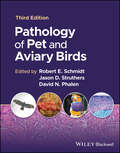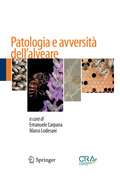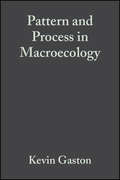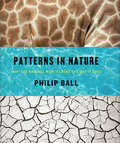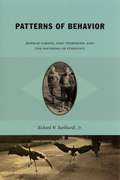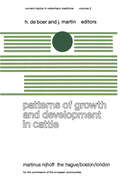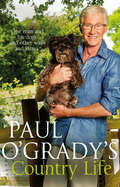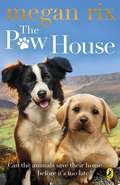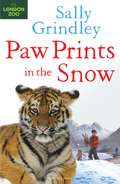- Table View
- List View
Pathology of Pet and Aviary Birds
by Robert E. Schmidt Drury R. Reavill David N. PhalenPathology of Pet and Aviary Birds, Second Edition provides a comprehensive reference to the gross and histologic features of diseases seen in pet and aviary birds, with more than 850 images depicting disease lesions. • Provides a complete resource for identifying both common and not-so-common diseases in a wide range of avian species • Includes more than 850 full-color images to show disease lesions• Offers context for the interpretation of pathologic findings, promoting an understanding of the pathogenesis and epizootiology of disease• Adds information on pigeons and chickens, pathophysiology, prognosis and trends, and globally relevant diseases• Aids pathologists, diagnosticians, and avian veterinarians in identifying lesions in pet birds
Pathology of Pet and Aviary Birds
by Robert E. Schmidt Drury R. Reavill David N. PhalenPathology of Pet and Aviary Birds, Second Edition provides a comprehensive reference to the gross and histologic features of diseases seen in pet and aviary birds, with more than 850 images depicting disease lesions. • Provides a complete resource for identifying both common and not-so-common diseases in a wide range of avian species • Includes more than 850 full-color images to show disease lesions• Offers context for the interpretation of pathologic findings, promoting an understanding of the pathogenesis and epizootiology of disease• Adds information on pigeons and chickens, pathophysiology, prognosis and trends, and globally relevant diseases• Aids pathologists, diagnosticians, and avian veterinarians in identifying lesions in pet birds
Pathology of Pet and Aviary Birds
by Robert E. Schmidt Jason D. Struthers David N. PhalenPathology of Pet and Aviary Birds A complete reference for veterinary pathologists, residents, and students interested in avian diseases The revised third edition of Pathology of Pet and Aviary Birds delivers a comprehensive reference to gross and microscopic lesions found in birds, as well as the implications of these diseases. This third edition includes improved coverage of normal anatomy and of advanced diagnostic techniques, including special stains, immunohistochemistry, in situ hybridization, and molecular diagnostics. The authors offer an extensive collection of more than 1200 high-quality, full-color images. New chapters cover the postmortem examination; gross and microscopic anatomy; advanced diagnostics; and cytology. Specific chapters address diseases of passerines, Columbidae, and raptors, and other chapters are intuitively organized by body system. The book also provides: A thorough introduction to the preparation and interpretation of cytological samples Comprehensive tables of infectious diseases and published avian primers and IHC markers Practical discussion of diseases of the liver, urinary system, reproductive system, respiratory system, cardiovascular system, nervous system, alimentary system, integument, special senses, and more.High-quality and annotated macroscopic and microscopic images that bolster the text and benefit the reader Pathology of Pet and Aviary Birds is an essential resource for veterinary pathologists and pathology residents, and will also benefit avian practitioners and veterinary students with an interest in diseases of pet birds and birds in avicultural collections. As many diseases in captive birds also manifest in wild birds, the book will appeal to those interested in the diseases and pathology of wild birds.
Pathology of Pet and Aviary Birds
by Robert E. Schmidt Jason D. Struthers David N. PhalenPathology of Pet and Aviary Birds A complete reference for veterinary pathologists, residents, and students interested in avian diseases The revised third edition of Pathology of Pet and Aviary Birds delivers a comprehensive reference to gross and microscopic lesions found in birds, as well as the implications of these diseases. This third edition includes improved coverage of normal anatomy and of advanced diagnostic techniques, including special stains, immunohistochemistry, in situ hybridization, and molecular diagnostics. The authors offer an extensive collection of more than 1200 high-quality, full-color images. New chapters cover the postmortem examination; gross and microscopic anatomy; advanced diagnostics; and cytology. Specific chapters address diseases of passerines, Columbidae, and raptors, and other chapters are intuitively organized by body system. The book also provides: A thorough introduction to the preparation and interpretation of cytological samples Comprehensive tables of infectious diseases and published avian primers and IHC markers Practical discussion of diseases of the liver, urinary system, reproductive system, respiratory system, cardiovascular system, nervous system, alimentary system, integument, special senses, and more.High-quality and annotated macroscopic and microscopic images that bolster the text and benefit the reader Pathology of Pet and Aviary Birds is an essential resource for veterinary pathologists and pathology residents, and will also benefit avian practitioners and veterinary students with an interest in diseases of pet birds and birds in avicultural collections. As many diseases in captive birds also manifest in wild birds, the book will appeal to those interested in the diseases and pathology of wild birds.
Pathology of Small Mammal Pets
by Patricia V. Turner Marina L. Brash Dale A. SmithPathology of Small Mammal Pets presents a ready reference for veterinarians, veterinary pathologists, and technicians who work with small mammal companion animals. Provides up-to-date, practical information on common disease conditions in small mammal companion animals Offers chapters logically organized by species, with comprehensive information on diagnosing diseases in each species Takes a practical, system-based approach to individual disease conditions Covers clinical signs, laboratory diagnostics, gross pathology, histopathology, and differential diagnoses in detail Includes relevant information for conventional breeding operations and breeding facilities, with strategies for disease management in herds and colonies Features information on normal anatomy in included species to assist in recognizing pathology
Pathology of Small Mammal Pets
by Patricia V. Turner Marina L. Brash Dale A. SmithPathology of Small Mammal Pets presents a ready reference for veterinarians, veterinary pathologists, and technicians who work with small mammal companion animals. Provides up-to-date, practical information on common disease conditions in small mammal companion animals Offers chapters logically organized by species, with comprehensive information on diagnosing diseases in each species Takes a practical, system-based approach to individual disease conditions Covers clinical signs, laboratory diagnostics, gross pathology, histopathology, and differential diagnoses in detail Includes relevant information for conventional breeding operations and breeding facilities, with strategies for disease management in herds and colonies Features information on normal anatomy in included species to assist in recognizing pathology
Pathophysiology of Headaches: From Molecule to Man (Headache)
by Messoud Ashina Pierangelo GeppettiThis book provides a detailed overview of the current state of knowledge regarding the pathophysiology of both primary headaches – migraine, tension-type headache (TTH), and cluster headache – and the very important and frequent type of secondary headache, medication overuse headache (MOH). After an introductory chapter describing relevant neuroanatomy and vascular anatomy, the evidence gained from animal models regarding the pathophysiology of migraine and the other primary headaches is reviewed. Knowledge of the genetic component in the different types of headache is then examined with reference to recent evidence, for example regarding the implication of the trigeminovascular system and cortical spreading depression in migraine. Detailed information is provided on insights into primary headaches from imaging studies, including functional magnetic resonance imaging and positron emission tomography and on their neurophysiology and biochemistry. A further series of important chapters describe present knowledge of the pathophysiology of each specific type of headache and consider future directions. Written by acknowledged experts in their fields from Europe and the United States, clinicians and students will find Pathophysiology of Headaches to be an excellent source of up-to-date information on why patients experience headaches. In addition, it will be of value for pain researchers investigating the underlying mechanisms of headache.
Patologia e avversità dell’alveare
by Emanuele Carpana Marco LodesaniIn questo volume vengono descritti i numerosi aspetti della patologia delle api con prospettive diverse e molteplici, tali da raggiungere destinatari diversi: l’apicoltore, il tecnico addetto all’assistenza sanitaria, il veterinario, il naturalista, il ricercatore, lo studente. Accanto alle nozioni più aggiornate, infatti, sono sempre presenti un gran numero di indicazioni operative. A un livello tecnico-scientifico vengono affrontate tutte le patologie conosciute delle api e, più in generale, le problematiche sanitarie dell’apicoltura: dall’epidemiologia alla normativa, dalle avversità ambientali ai residui nei prodotti dell’alveare. Le indicazioni tecniche, soprattutto nel campo della profilassi, rendono questo volume particolarmente interessante anche dal punto di vista pratico, anche grazie a un apparato iconografico particolarmente ricco.
The Patron Saint of Lost Dogs: A Novel
by Dr. Nick TroutDr. Cyrus Mills returns to his hometown after inheriting his father's failing veterinary practice. Cyrus intends to sell the practice and get out of town as fast as he can, but when his first patient -- a down-on-her-luck golden retriever named Frieda Fuzzypaws -- wags her way through the door, life suddenly gets complicated. With the help of a black Labrador gifted in the art of swallowing underwear, a Persian cat determined to expose her owner's lover as a gold digger, and the allure of a feisty, pretty waitress from the local diner, Cyrus gets caught up in a new community and its endearing residents, both human and animal. Sensing he may have misjudged the past, he begins to realize it's not just his patients that need healing.The Patron Saint of Lost Dogs is a winsome tale of new beginnings, forgiveness, and the joy of finding your way home.
The Patterdale Terrier
by Sean FrainInvaluable handbook for both owners and prospective owners of the breed. The book covers owning a Patterdale as a pet, training from puppy to adulthood, and has a useful chapter on breeding.
Pattern and Process in Macroecology
by Kevin Gaston Tim BlackburnIssues of scale have become increasingly important to ecologists. This book addresses the structure of regional (large-scale) ecological assemblages or communities, and the influence this has at a local (small-scale) level. This macroecological perspective is essential for the broader study of ecology because the structure and function of local communities cannot be properly understood without reference to the region in which they are situated. The book reviews and synthesizes the issues of current importance in macroecology, providing a balanced summary of the field that will be useful for biologists at advanced undergraduate level and above. These general issues are illustrated by frequent reference to specific well-studied local and regional assemblages -- an approach that serves to relate the macroecological perspective (which is perhaps often difficult to comprehend) to the everyday experience of local sites. Macroecology is an expanding and dynamic discipline. The broad aim of the book is to promote an understanding of why it is such an important part of the wider program of research into ecology. Summarises the current macroecological literature. Provides numerous examples of key patterns. Explicitly links local and regional scale processes. Exploits detailed knowledge of one species assemblage to explore broad issues in the structuring of biodiversity.
Patterns in Freshwater Fish Ecology
by William J. MatthewsNearly a decade ago I began planning this book with the goal of summarizing the existing body of knowledge on ecology of freshwater fishes in a way similar to that of H. B. N. Hynes' comprehensive treatise Ecology of Running Waters for streams. The time seemed appropriate, as there had been several recent volumes that synthesized much information on a range of topics important in fish ecology, from biogeographic to local scales. For example, the "Fish Atlas" (Lee et aI. , 1980) had provided range maps and basic entry to the original literature for all freshwater fishes in North America, and in 1986 Hocutt and Wiley's Zoogeography of North American Fishes provided a detailed synthesis of virtually everything known about distributional ecology of fishes on that continent. Tim Berra (1981) had summarized in convenient map form the worldwide distribution of all freshwater fish families, and Joe Nelson's 1976 and 1984 editions of Fishes of the World had appeared. To complement these "big picture" views of fish distributions, the volume on Community and Evolutionary Ecology of North American Freshwater Fishes, edited by David Heins and myself (Matthews and Heins, 1987), had provided an opportunity for more than 30 individuals or groups to summarize their work on stream fishes (albeit mostly for warmwater systems).
Patterns in Nature: Why the Natural World Looks the Way It Does
by Philip BallThough at first glance the natural world may appear overwhelming in its diversity and complexity, there are regularities running through it, from the hexagons of a honeycomb to the spirals of a seashell and the branching veins of a leaf. Revealing the order at the foundation of the seemingly chaotic natural world, Patterns in Nature explores not only the math and science but also the beauty and artistry behind nature’s awe-inspiring designs. Unlike the patterns we create in technology, architecture, and art, natural patterns are formed spontaneously from the forces that act in the physical world. Very often the same types of pattern and form – spirals, stripes, branches, and fractals, say—recur in places that seem to have nothing in common, as when the markings of a zebra mimic the ripples in windblown sand. That’s because, as Patterns in Nature shows, at the most basic level these patterns can often be described using the same mathematical and physical principles: there is a surprising underlying unity in the kaleidoscope of the natural world. Richly illustrated with 250 color photographs and anchored by accessible and insightful chapters by esteemed science writer Philip Ball, Patterns in Nature reveals the organization at work in vast and ancient forests, powerful rivers, massing clouds, and coastlines carved out by the sea. By exploring similarities such as those between a snail shell and the swirling stars of a galaxy, or the branches of a tree and those of a river network, this spectacular visual tour conveys the wonder, beauty, and richness of natural pattern formation.
Patterns in Nature: Why the Natural World Looks the Way It Does
by Philip BallThough at first glance the natural world may appear overwhelming in its diversity and complexity, there are regularities running through it, from the hexagons of a honeycomb to the spirals of a seashell and the branching veins of a leaf. Revealing the order at the foundation of the seemingly chaotic natural world, Patterns in Nature explores not only the math and science but also the beauty and artistry behind nature’s awe-inspiring designs. Unlike the patterns we create in technology, architecture, and art, natural patterns are formed spontaneously from the forces that act in the physical world. Very often the same types of pattern and form – spirals, stripes, branches, and fractals, say—recur in places that seem to have nothing in common, as when the markings of a zebra mimic the ripples in windblown sand. That’s because, as Patterns in Nature shows, at the most basic level these patterns can often be described using the same mathematical and physical principles: there is a surprising underlying unity in the kaleidoscope of the natural world. Richly illustrated with 250 color photographs and anchored by accessible and insightful chapters by esteemed science writer Philip Ball, Patterns in Nature reveals the organization at work in vast and ancient forests, powerful rivers, massing clouds, and coastlines carved out by the sea. By exploring similarities such as those between a snail shell and the swirling stars of a galaxy, or the branches of a tree and those of a river network, this spectacular visual tour conveys the wonder, beauty, and richness of natural pattern formation.
Patterns in Nature: Why the Natural World Looks the Way It Does
by Philip BallThough at first glance the natural world may appear overwhelming in its diversity and complexity, there are regularities running through it, from the hexagons of a honeycomb to the spirals of a seashell and the branching veins of a leaf. Revealing the order at the foundation of the seemingly chaotic natural world, Patterns in Nature explores not only the math and science but also the beauty and artistry behind nature’s awe-inspiring designs. Unlike the patterns we create in technology, architecture, and art, natural patterns are formed spontaneously from the forces that act in the physical world. Very often the same types of pattern and form – spirals, stripes, branches, and fractals, say—recur in places that seem to have nothing in common, as when the markings of a zebra mimic the ripples in windblown sand. That’s because, as Patterns in Nature shows, at the most basic level these patterns can often be described using the same mathematical and physical principles: there is a surprising underlying unity in the kaleidoscope of the natural world. Richly illustrated with 250 color photographs and anchored by accessible and insightful chapters by esteemed science writer Philip Ball, Patterns in Nature reveals the organization at work in vast and ancient forests, powerful rivers, massing clouds, and coastlines carved out by the sea. By exploring similarities such as those between a snail shell and the swirling stars of a galaxy, or the branches of a tree and those of a river network, this spectacular visual tour conveys the wonder, beauty, and richness of natural pattern formation.
Patterns in Nature: Why the Natural World Looks the Way It Does
by Philip BallThough at first glance the natural world may appear overwhelming in its diversity and complexity, there are regularities running through it, from the hexagons of a honeycomb to the spirals of a seashell and the branching veins of a leaf. Revealing the order at the foundation of the seemingly chaotic natural world, Patterns in Nature explores not only the math and science but also the beauty and artistry behind nature’s awe-inspiring designs. Unlike the patterns we create in technology, architecture, and art, natural patterns are formed spontaneously from the forces that act in the physical world. Very often the same types of pattern and form – spirals, stripes, branches, and fractals, say—recur in places that seem to have nothing in common, as when the markings of a zebra mimic the ripples in windblown sand. That’s because, as Patterns in Nature shows, at the most basic level these patterns can often be described using the same mathematical and physical principles: there is a surprising underlying unity in the kaleidoscope of the natural world. Richly illustrated with 250 color photographs and anchored by accessible and insightful chapters by esteemed science writer Philip Ball, Patterns in Nature reveals the organization at work in vast and ancient forests, powerful rivers, massing clouds, and coastlines carved out by the sea. By exploring similarities such as those between a snail shell and the swirling stars of a galaxy, or the branches of a tree and those of a river network, this spectacular visual tour conveys the wonder, beauty, and richness of natural pattern formation.
Patterns of Behavior: Konrad Lorenz, Niko Tinbergen, and the Founding of Ethology
by Richard W. BurkhardtIt is hard to imagine, by their very name, the life sciences not involving the study of living things, but until the twentieth century much of what was known in the field was based primarily on specimens that had long before taken their last breaths. Only in the last century has ethology—the study of animal behavior—emerged as a major field of the life sciences. In Patterns of Behavior, Richard W. Burkhardt Jr. traces the scientific theories, practices, subjects, and settings integral to the construction of a discipline pivotal to our understanding of the diversity of life. Central to this tale are Konrad Lorenz and Niko Tinbergen, 1973 Nobel laureates whose research helped legitimize the field of ethology and bring international attention to the culture of behavioral research. Demonstrating how matters of practice, politics, and place all shaped "ethology's ecologies," Burkhardt's book offers a sensitive reading of the complex interplay of the field's celebrated pioneers and a richly textured reconstruction of ethology's transformation from a quiet backwater of natural history to the forefront of the biological sciences. Winner of the 2006 Pfizer Awad from the History of Science Society
Patterns of Growth and Development in Cattle: A Seminar in the EEC Programme of Coordination of Research on Beef Production held at Ghent, October 11–13, 1977 (Current Topics in Veterinary Medicine #2)
by H. De Boer J. MartinThis publication contains the proceedings of a seminar held in Ghent, Belgium on October 11th-13th 1977, under the auspices of the Commission of the European Communities, as part of the EEC programme of co-ordination of research on beef production. The seminar was initiated by the scientific working group on 'Carcass and Meat Quality' and attracted the interest of the working groups on 'Genetics and Selection' and on 'Nutrition and Management'. Consequently it developed into a multi-disciplinary programme, organised under the responsibility of the working group on Carcass and Meat Quality. This group comprised Ir. H. de Boer (Chairman), Netherlands; Prof. R. Boccard, France; Dr D.E. Hood, Ireland; Dr R.W. Pomeroy, UK; Dr A. Romita, Italy; Professor Dr L. Sch~n, Fed. Rep. of Germany; Mr P. L'Hermite, CEC; and Dr J.C. Tayler, UK (adviser to the CEC). In view of the broad scope of the subject, a special plan ning meeting was organised, involvi.ng experts from the different disciplines involved. The additional participants were: Dr B. Bech Andersen, Denmarkj Dr A.J.H. van Es, Netherlands; Prof. Dr J. Martin, Belgium; Dr. St.C.S. Taylor, UK. The multidisciplinary scope of this ~eminar follows a series of seminars in 1975-76 on more specific aspects of beef production research in the individual fields involved. It seems logical that further seminars should integrate the approaches by different disciplin~s in order to achieve a balanced programme of research on the very complex topic of beef production.
Patterns of Parental Behavior: From Animal Science to Comparative Ethology and Neuroscience (Advances in Neurobiology #27)
by Gabriela González-MariscalModern neuroscience has presented new opportunities for exploring the molecular and neural mechanisms controlling specific social responses. This book reviews insights into the neural circuits underlying a particularly fascinating form of social interaction, parental behavior. This book presents a detailed review of maternal and paternal behavior of particular mammalian species. It offer neuroscientists a spectrum of specific mammals that can be used as experimental models to explore particular topics on the functions of the nervous system. It shows that results coming from the laboratory can be translated into useful information for raising mammals on the farm, and it stimulates biologists to gain insights into the underpinnings of the complex mechanisms governing mammalian behavior in the wild. It also discusses the implications of this research for human parental behavior.
Patterns of Vertebrate Biology
by E.W. Jr. JamesonThis book grew from a series of lectures on vertebrate natural history. The topics have been developed over a period of nearly 30 years, and today scarcely resemble the original subject matter. The progress is primarily technical. Some concepts provide a synthetic framework for viewing much modern research, but many of these concepts either date from Darwin or have developed from obser vations of later students. Animal science courses follow a sequential pattern in which there are three discrete levels of undergraduate instruction. Initially, students study subject mat ter contained in such courses as biology and general zoology. These courses intro duce students to animal phylogeny, basic plans of morphology and certain phys iological aspects; incidental to these subjects the student acquires a broad zoological vocabulary. At the other end of the academic spectrum are courses that emphasize synthe sis and theory: evolution, zoogeography, behavior and ecology are important courses whose role is to explore the relationships of various aspects of the physical and biological world. In these courses theory and analysis prevail. They are not, however, essentially "subject matter" courses with distinct bodies of knowledge.
Paul O'Grady's Country Life: Heart-warming and hilarious tales from Paul
by Paul O'Grady**THE SUNDAY TIMES BESTSELLER**Paul O'Grady's Country Life for the first time gives a glimpse into the home life of one of Britain’s best loved stars, alongside the animals he adores. Sometimes rural idyll, sometimes hell on earth, Paul’s life in rural Kent has been shared over the years with some very vocal pigs, a mad cow, various rescued barn owls, the world’s most sadistic geese and Christine the psychotic sheep – among many other animal waifs and strays. And of course Paul tells the stories of the dogs in his life – including the tiny chihuahua/Jack Russell cross with Napoleonic ambitions, Eddie, Miss Olga, Bullseye, Louis, Boycie and, of course, Buster, the greatest canine star since Lassie. In addition, Paul shares some of his favourite recipes, explores country lore and superstitions, and extols the benefits of growing your own vegetables, herbs and fruit.This is a warts-and-all account of country living, as far removed from the bright lights of celebrity as you could ever imagine. The trials and tribulations Paul experienced on moving to deepest darkest Kent as a dyed-in-the-wool city dweller are every bit as hilarious and eventful as you would think. He had a lot of new skills to learn, and fast: everything from how to churn your own butter and how to birth a lamb to the best way to lure a cow out of your kitchen while naked from the waist down.Brilliantly funny and full of classic stories, Paul O’Grady’s Country Life is your armchair guide to the wonders and horrors of rural existence.
The Paw House
by Megan RixHamish's summer isn't going as planned. First, his parents left him to go on a business trip to Japan, and now he's found himself stuck in the Scottish highlands with an aunt he's never met, a grumpy girl called Izzy, and a lot of animals. He's never even stroked a dog - what on earth is he supposed to do here? Before long Hamish finds himself taking the dogs for walks, adopting a piglet, even rescuing a tiny puppy in the dead of night. But something's not right: Aunt Helen is worried about the future of the sanctuary, and with more animals in need arriving every day, something's got to be done before they lose their home forever. With the help of some unexpected new friends, can Hamish save the animals and turn the fate of the Paw House around?
Paw Print - Dog (UEB uncontracted)
by Adrian FarnsworthThe page shows an image of a dog's paw print. There are four smaller pads of the toes each with a small triangular print of a claw up the page. At the bottom of the page is the larger main pad of the paw.
Paw Prints in the Snow
by Sally GrindleyTwo children accompany their parents as they travel the world helping animals on the verge of extinction. As their parents work alongside international agencies, the children have their own thrilling adventures. Paw Prints in the Snow is written with the assistance and guidance of London Zoo's conservation team. All information is accurate and the stories are full of excitement and tension.Sally Grindley is the author of bestselling and award-winning fiction for young readers. Here she brings to life a story of hope set in Russia.When Joe and Aesha's mother is given an assignment to train young vets, the Brook family visits an important nature reserve near Lazovsky in eastern Russia. In this spectacular snow-bound landscape, Joe is thrilled by the prospect of glimpsing a rare Amur tiger in the wild. Alongside the fieldworkers, the Brooks get involved in tracking local species, such as the Asiatic black bear and the raccoon dog. However, the tigers prove elusive - until Joe's interest in wildlife photography leads him to make an unexpected discovery that puts his very life in danger.
Paws: This Book Will Help You Take a Break
by Ally FrancisCats have mastered the art of chilling out and, with a little help from this book, now you can too! Turn to this collection of care-free kitties for a dose of relaxation and inspiration. It’s the purr-fect way to press ‘paws’ and enjoy a few moments of peace and quiet.

